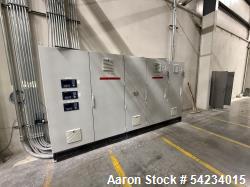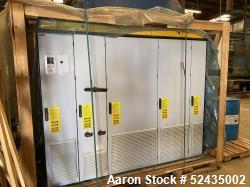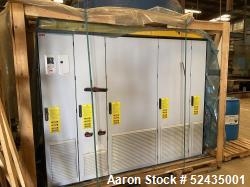Used Electrical Equipment
Aaron Equipment has an inventory of reconditioned, unused, and used electrical equipment including circuit breakers, starters and transformers. Industrial electrical equipment refers to devices, systems, and components used in industrial settings to generate, distribute, control, and utilize electrical power. These are designed to handle high-power loads, ensure operational safety, and meet the needs of manufacturing, processing, and other heavy-duty industrial applications. If you are looking to sell your used electrical equipment submit a request online or contact Erik Eichert at 630-238-7480.
Your Guide To Understanding Electrical Transformers and Inverters
The importance of energy efficiency and renewable energy systems cannot be overstated in today's world. At the heart of many of these systems are electrical transformers and inverters. Understanding how these devices work can help you make informed decisions, whether upgrading your home systems or managing a large-scale energy project.
What Are Electrical Transformers?
Electrical transformers change the voltage of electricity flowing through power lines. They are essential in ensuring that electricity can be safely and efficiently transported from power plants to homes and businesses.
- Types of Transformers
There are several types of transformers, each suited to different applications:- Power Transformers: These are used in transmission networks to increase or decrease voltage levels. They are typically found in power plants or substations.
- Distribution Transformers: These provide the final voltage transformation in the electric power distribution system, stepping down the voltage used in the distribution lines to the level used by the customer.
- Dry-Type Transformers: Unlike their oil-filled counterparts, dry-type transformers use air as the cooling medium. They are often used in environments where oil leaks could pose a significant risk, such as indoors or in renewable energy systems.
- How Transformers Work
Transformers work on the principle of electromagnetic induction. They consist of two or more coils of wire, known as windings, wound around a core. When electricity flows through the primary winding, it creates a magnetic field. This magnetic field induces a voltage in the secondary winding, which changes the voltage level.
Introduction to Inverters
Inverters convert direct current (DC) into alternating current (AC). This is particularly important in renewable energy systems, such as solar panels, where the electricity generated is in DC form but needs to be converted to AC for use in homes and businesses.
- Types of Inverters
There are various types of inverters, each with its specific applications:- String Inverters: These are commonly used in solar power systems, where multiple solar panels are connected in series to form a string.
- Microinverters: These are small inverters installed on each solar panel. They provide several advantages, including improved energy efficiency and system flexibility.
- Central Inverters are used in large-scale solar power installations. They convert the DC output of multiple solar panels into AC.
- How Inverters Work
- Inverters use electronic circuits to switch the DC's direction, rapidly creating an AC. This process involves using semiconductors to modulate the flow of electricity, effectively transforming it from a continuous flow into an oscillating wave.
- The Role of Transformers and Inverters in Renewable Energy Systems
Energy Efficiency
The increasing focus on renewable energy has made transformers and inverters more critical. Here's how they fit into the picture:
- Both transformers and inverters play a significant role in ensuring energy efficiency. Transformers reduce energy losses by adjusting voltage levels, while inverters minimize losses during the conversion process from DC to AC.
Integration with Renewable Energy
In renewable energy systems, such as solar and wind, inverters are essential for converting the electricity generated into usable form. On the other hand, transformers adjust voltage levels for efficient transmission and distribution.
The Importance of Starters in Electrical Systems
While discussing electrical systems, it's also essential to mention starters. Starters are devices used to start and stop motors safely. They help protect the motor from electrical faults and overloads, ensuring a longer lifespan and efficient operation.
- Types of Starters
- Direct On-Line Starters (DOL): These are the most spartan starters for small motors.
- Star-Delta Starters: These are used to start large motors in a star configuration and run them in a delta configuration.
- Soft Starters: These gradually increase voltage to the motor, allowing for a smooth start.
Choosing the Right Equipment for Your Needs
You must consider your specific needs and applications when selecting transformers, inverters, or starters. Here are some factors to consider:
- For Transformers:
- Capacity: Ensure the transformer can handle the required power load.
- Cooling Method: Choose oil-filled and dry-type transformers based on your environment and safety requirements.
- For Inverters
- Efficiency: Look for inverters with high-efficiency ratings to maximize energy savings.
- Compatibility: Ensure the inverter is compatible with your existing electrical systems and renewable energy sources.
- For Starters
- Motor Size: Choose a starter that matches the size and type of your motor.
- Protection Features: Look for starters with built-in protection features to safeguard your motors.
Top Electrical Equipment Brands
While there are many reputable manufacturers, the market has shown a preference for the following brands:
- ABB, Alan Bradley, Siemens, GE, and many more!
Understanding electrical transformers and inverters is essential for anyone involved in energy management or renewable energy systems. Choosing the right equipment and understanding their roles can enhance energy efficiency, reduce costs, and contribute to a more sustainable future. Knowing these critical components will empower you to make informed decisions and drive positive change in your energy systems as the world moves towards cleaner energy solutions.


